Oct 27 2010
Enamored With Cabernet Franc
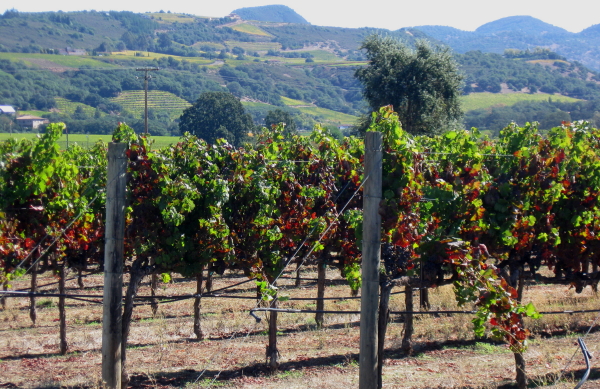
As the sun’s late October golden afternoon rays catch the warm autumnal hues that paint surrounding vineyards, it is easy to get lost in Napa Valley’s immediate surrounding beauty and even catch your cheeks with a seasonally fitting crimson blush. Napa Valley is romantic in many respects but spending fall here will bring out the budding impressionist in many. There are aromas of grapes being crushed from harvest to make wine as must lingers enchantingly in the air. Thumbs are often stained a certain shade of plum hinting at the evidence of true craftsmanship left at a winery not far away. It is a busy time in Napa Valley as vintners hurry in preparation to stow away the fruits of harvest for barrel and bottle aging over winter.
Perhaps fitting for fall, is a red grape varietal that can be equally romantic as wine country, yet is often overlooked, Cabernet Franc. Most readily are aware that Cabernet Franc is a red wine grape that is often blended into Cabernet Sauvignon. Countless times I have met individuals who just prefer Cabernet Sauvignon (which can be understandable) but there is often a notable lack of understanding about the Cabernet Franc grape itself.
Cabernet Franc, one of the Bordeaux grapes mentioned in last week’s article, is actually of very similar structure and flavor to Cabernet Sauvignon. It merely is not as full-bodied as the Cabernet Sauvignon grape itself. The wine as a single varietal sets itself apart for being readily accessible; a well grown Cabernet Franc grape is lower in acidity and tannins. Couple in the fact that Cabernet Franc when grown in an idyllic cooler climate will have tremendous aromatic and herbaceous qualities, it begins to become understandable that this grape may do more heavy lifting in that Cabernet Sauvignon wine than most are ready to admit. In fact, in a year where Cabernet Sauvignon may not be up to its full potential, Cabernet Franc is relied upon in greater percentages to help maintain the quality of the Cabernet Sauvignon wine that a person has grown attached to vintage after vintage. In sum, Cabernet Franc has had its moments to actually save the day in the world of winemaking.
Looking at Cabernet Franc as a single varietal bottled wine, aside from smooth finely ground tannins and lower acidity, the main characteristic to seek is the aromatic and herbaceous nature of this particular grape. The increased aromatics will come from being grown in the right climate. Taking this into account, it is with great pleasure to share this week a Cabernet Franc that far surpasses this above test and boasts estate-grown grapes from a family owned winery in Napa Valley: Casa Nuestra Winery’s 2006 Cabernet Franc.
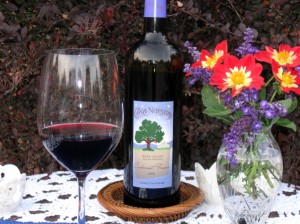
Casa Nuestra Winery (“Casa Nuestra”) has been featured this past summer with some terrific seasonal wines but does not disappoint the wine connoisseur as the palate shifts to desire red wines in the fall and winter. As previously mentioned Casa Nuestra grows its own Cabernet Franc (making the grapes estate-grown) and has been confidently offering it as a single varietal since the 1980’s. Part of the confidence in bottling their Cabernet Franc as a stand-alone varietal must reside in Gene Kirkham’s knowledge that his grapes have “got it right”. Opening the bottle, before the wine even dares to meet the glass, aromas escape like a genie from a bottle to hint at mint, ripe berries and spices. Pouring the wine into the glass, it is easy on the eyes as it offers beautiful plum colors with soft rose petal edges drawing the imagination to images of refined luxury. The wine’s bouquet does not disappoint the nose as it enchants with a lovely perfume of ripe mountain berries, a trace of garden-grown mint, alluring baking spices and a romantic twist of clove. On the palate, there is one word to describe Casa Nuestra’s 2006 Cabernet Franc and that is “delicious.” Sensual warm spices race forward to greet the front of the palate. At mid-palate, a delicious blend of dark and red berries wash onward while a notable beautiful hint of eucalyptus and rose petal aromas waft upwards. The wine coasts into the sunset with a soft finish of bing cherry almond compote. Each swallow perks the attention, as the palate enjoys the wine readily while savoring and finishing with the inclination to cozy up to this Cabernet Franc and get to know it just a little bit better.
Casa Nuestra’s 2006 Cabernet Franc is indeed outstanding for a single varietal wine and if my own reaction was not enough, I carefully watched my guest’s reaction which included blushing crimson cheeks as he realized the magnitude of gem that had been poured into his glass.
Coming back to reality, to pair a wine such as Cabernet Franc successfully with food, certain elements need to be taken into consideration: it has a lower acidity, it is not as full-bodied as a Cabernet Sauvignon, its tannins are less and it has a magnificent bouquet that cannot be lost in the dish. Under such consideration, this week’s menu hosts:
· B(no L)T-Burrata
As a forewarning, this appetizer is not for vegans (nor vegetarians), but let the rest of the foodies rejoice because this recipe scandalously introduces bacon to burrata and creates a texturally, flavorful decadent crostini.
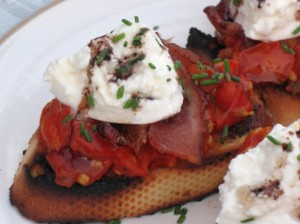
Burrata is heaven for anyone who is a fan of fresh mozzarella. The cheese itself is made from a combination of fresh mozzarella and cream. While being made, the cheese is made into a pouch and filled with mozzarella scraps and fresh cream (“panna”) before it is closed and stored in liquid. The cheese, Burrata, spoils quickly as the outer shell is meant to be thinner in order to convey the delicate consistency. Because of the short shelf-life, while Burrata originated in Italy in the 1920’s, it was largely unknown to American cuisine until somewhat recently as it could not be shipped. Now in the last decade or so, some purveyors of Italian cheese are releasing a Burrata, but if it is not made relatively locally, it will not be as delicate a version as the cheese is meant to be. Nevertheless, some of these distributed varieties are still enjoyable and the essence of Burrata’s rich buttery, sweet yet milky flavor is present.
But how can a semi-creamy cheese pair with a red wine?
Burrata, due to its fat content, can be paired with a red wine provided that the selection is made with care. The alcohol content of the red wine selected cannot be high and since Casa Nuestra’s 2006 Cabernet Franc is only 13.7%, it will pair well. Recalling that Cabernet Franc has less tannins and acidity, it also will not overwhelm the consistency and flavor of the cheese and can pair harmoniously alongside. Including Apple Smoked Bacon with the cheese adds a clearly delicious smoky component yet a flavor that intuitively pairs well with Cabernet Franc as it masquerades with a similar flavor to Cabernet Sauvignon.
While the grape’s acidity is less, it can still be paired with dishes hosting tomatoes provided that the tomatoes are included with care. To instead highlight and accentuate the herbaceous notes of the Cabernet Franc, a combination of highly aromatic marjoram and thyme from the garden are used to season the freshly picked Carmelo tomatoes (also from the garden) prior to gently sautéing.
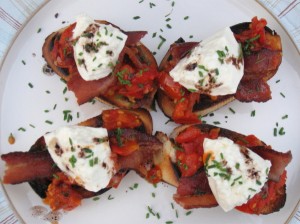
These ingredients are carefully stacked upon grilled slices of a locally baked French baguette and drizzled with a Balsamic Reduction Sauce and adorned with chopped chives from my garden.
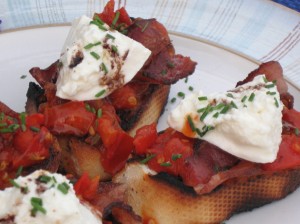
Bacon pairs so well with this Cabernet Franc. There are no gamey aspects to the Cabernet Franc, but its berry-oriented flavors naturally pair with the Apple Smoked Bacon. As initially odd as it may sound, bacon fat flavors are just delicious with this wine as it makes its berry and cherry finish robust and heady rendering the combination intoxicatingly seductive.
As mentioned above, Carmelo tomatoes are grown purposefully in my garden as they are known for a uniquely sweet flavor which effortlessly creates an oozy comfort food sensation in any dish where they are found. The trick to enamoring the palates of your guests, however, is the spices that are used. Opening a wine such as Casa Nuestra’s 2006 Cabernet Franc gives the chef a clear sensory palette with which to work. Marjoram in my garden is highly perfumed and makes me weak in the knees each time that I smell it. Include a herb like this in a dish and your guests will fall in love, yet just like new budding love not quite be able to put their finger on what it is that has captured their affection. When using fresh herbs from the garden in a dish when paired with this 2006 Cabernet Franc, it unleashes the true aphrodisiacal nature of this varietal.
A wine as aromatically inviting as Casa Nuestra’s 2006 Cabernet Franc, which sumptuously pairs so well with an appetizer as comfortingly savory as this one, will make any guest who you entertain wish that indeed this was “our house”.
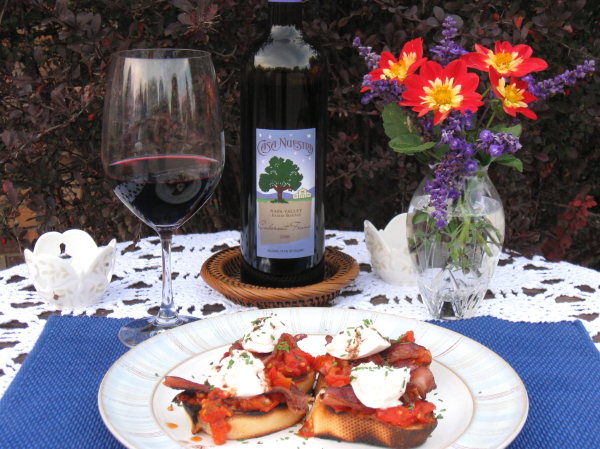
Comments Off on Enamored With Cabernet Franc